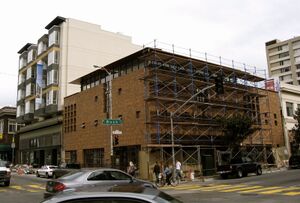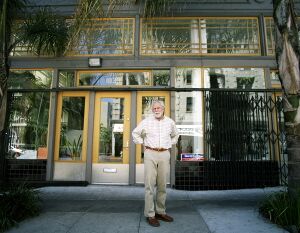“Bottom feeder” Bars to Upscale “Metrosexual” Bars
Text by Joey Plaster. Copyright (©) by C. Joey Plaster, 2009. All rights reserved.
The imagined queer, working-class utopia did not emerge. Undermining the gay male bar economy in particular were the skyrocketing commercial rents during the dot.com boom, the erosion of the cooperative bartender networks, an aging gay bar-going population, and the emergence of the Internet as both a social marketing tool and low-cost advertising method for commercialized sex. Reflecting these shifts, the Tavern Guild disbanded in 1995. Many of the Polk Street bar owners, who had purchased the property at the height of the gay bar economy in the 1970s, now retired and sold their bars as bar rents increased. Others, including Marvin Warren, passed away.
Mirroring the changes in the early 1960s, the faltering queer bars that formed the backbone of the Polk community became havens for young artists and “hipsters,” or upscale, heterosexual and mixed drinking establishments.
Bar owner Kimo Cochran made several changes to keep his bar “Kimos” profitable from 1977 to 2008. “First all I had to do was open the doors and the crowd was here every day,” he said. He organized drag shows after the onset of AIDS pummeled business, and in the 1990s hosted rock bands, drawing a young, primarily heterosexual crowd. “I’d say sometime 100% of the crowd is straight up there,” he said.[1]
Others bar owners reached a similar outcome by taking a more interventionist approach. In 2000, Steve Black bought out two gay bars across the street from Polk Street’s transgender club Divas – also the center of the city’s transgender prostitution district. He turned what he called magnets for “bottom-feeder gay men” into upscale bars, taking direct steps to change the clientele.
“With a vigilante spirit,” a 2006 article read, “he drove the transgender prostitutes out of the Lush Lounge [and] “chased drug dealers off the sidewalk,” leading to a hearing with the San Francisco Human Rights Commission. “His formula not only has worked to attract young barhoppers (most straight, some gay) but also is inspiring a new social scene,” the article read, mentioning several other upscale bars.[2]
The San Francisco Bay Times also noted, in 2005, a “trend …over the last few years as [Polk Street] Gay bars change hands, redecorate…then put in a bid for a new clientele; often straight, or predominantly ethnic or specifically higher toned—or in other words, hustler-free zones.”[3]
One of the most controversial examples of this shift was the relocation of the RendezVous bar in 2005, after the bar lost its lease and a newly formed neighborhood association opposed their relocation to alternate location on Polk Street. The only open business on the street at that time, the association faulted them for the homeless and hustlers who gathered in front and the shuttered buildings in front of and on either side of the bar.
In 2004, restaurant owner Myles O’Reilly also spent six million dollars to purchase and renovate a shuttered building on Polk Street across the street from the RendezVous bar. He says his financial investment led to the neighborhood association “decid[ing] to crank up the involvement of the merchants.”[4] They created a fund to hire private security and steam clean the alleyways, a favorite site for hustling and drug dealing.
By 2005, the neighborhood association had secured a $90,000 grant for from the Department for Public Works “for beautification issues,” Ron Case, an association co-chair, said.
“Then you’re walking along the street and it was that bad….There used to be young kids all up and down Polk Street, and [in front of RendezVous] was the last vestige of kids on the street that we saw.” “We started coming back to the planning department saying these aren’t good neighbors,” Case said. “We [told them we] don’t want them to move. And the planning department turned ‘em down.”[5]
By 2006, the City instituted a “Polk Street Commercial Corridor Revitalization and Stabilization Community Action Plan” to plan for “regular sidewalk power-washing…increased police presence…in specific hotspot areas such as drugs and prostitution…[and work to] fill vacant storefronts.” In 2008, the First Congregational Church, attracted to the area by the low rents and designed by Case’s architecture firm, sits on the ruins of the RendezVous along with high-end condominiums and a banking outlet.
“I think that the demise of the Polk Street gay scene was a natural progression,” said James Beales, a bartender at RendezVous. “I think business nowadays couldn’t support that many bars on the street…I was just upset that when we tried to hold the Club RondezVous as one last bastion of the gay history and culture on Polk Street…that we were stamped out like that at the end.”[6]
- ↑ Interview with Kimo Cochran by Joey Plaster, 2008.
- ↑ “The resurrection of Polk Street,” Oakland Tribune, May 22, 2005.
- ↑ “The Closing of a Bar…and the Rebirth of English Punk Rock,” San Francisco Bay Times, January 6, 2005.
- ↑ Interview with Myles O'Reilly by Joey Plaster, 2008.
- ↑ Interview with Ron Case by Joey Plaster, 2008.
- ↑ Interview with James Beales by Joey Plaster, 2008.

